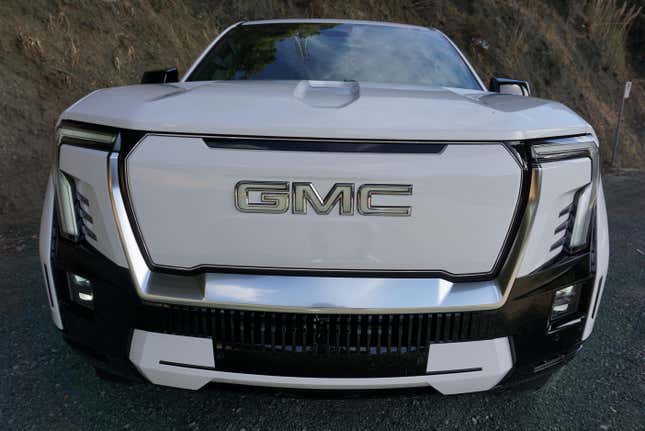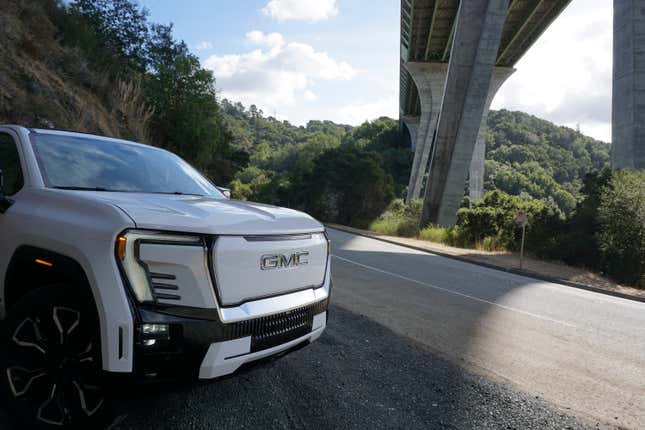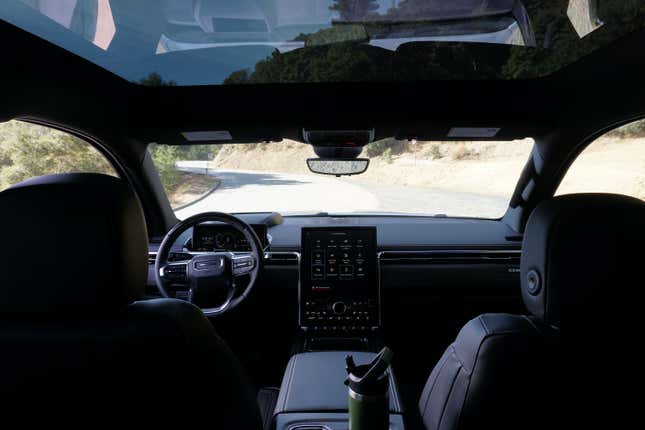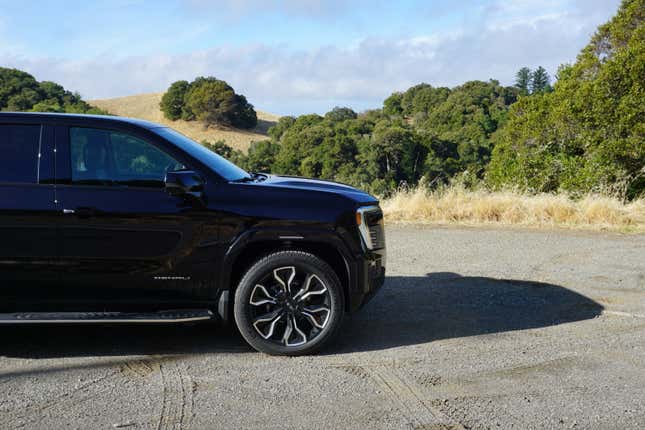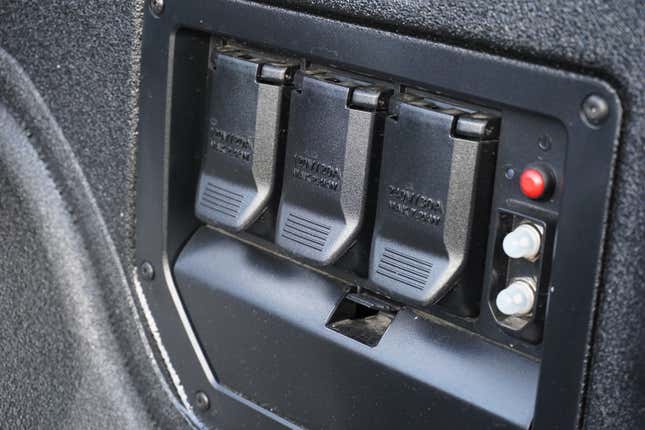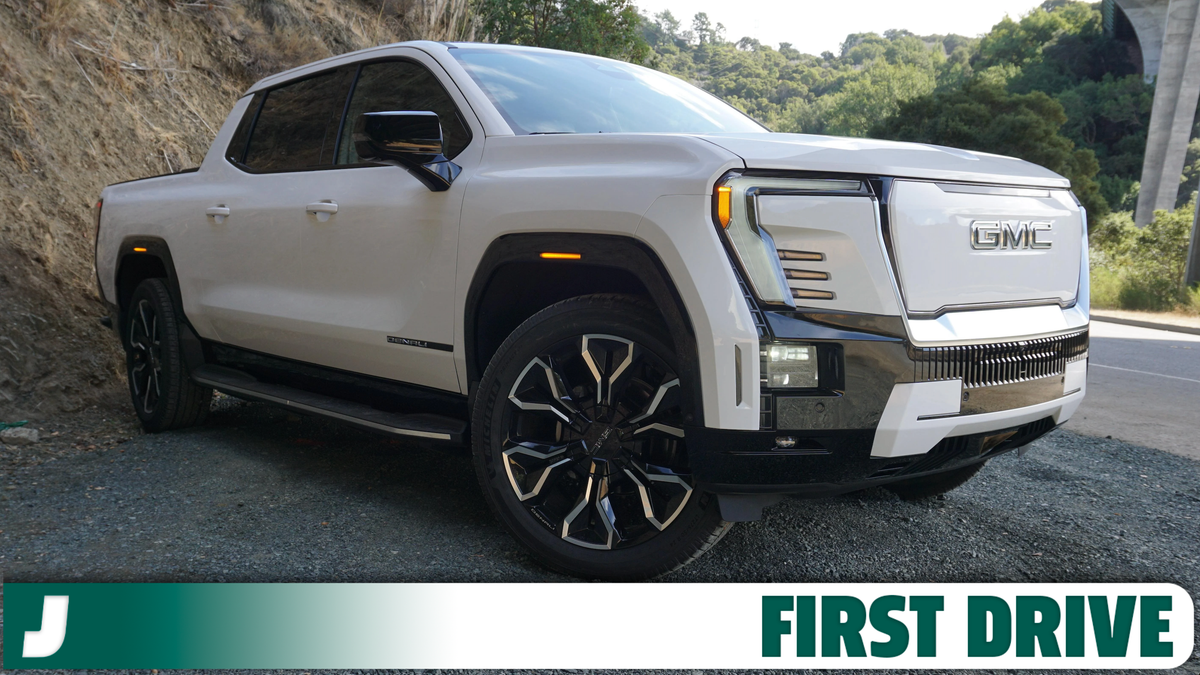I don’t usually give a shit about how much a car weighs. As long as it’s not some low-slung sports car it really isn’t something I put a lot of thought into, but sometimes it’s just impossible to ignore. That’s where I am with the 2025 GMC Sierra EV Denali. Normally, I wouldn’t care that its curb weight is 8,987 pounds, but it’s just inescapable in this massive electric pickup truck, to the Sierra’s detriment.
There’s a lot of stuff the Sierra EV Denali has going for it: Clever packaging, a class-leading range, a nearly price appropriate interior and solid tech. But its driving experience is downright disappointing, and a lot of that has to do with how goddamn heavy it is, among other things. A lot of engineering has to go into making a vehicle this heavy even vaguely OK to drive, but sometimes the laws of physics are just too much to overcome.
Full Disclosure: GMC flew me out to Northern California, fed me and put me up in a very nice hotel so I could drive the 2025 Sierra EV Denali.

I wouldn’t usually start off a pickup review by discussing how it drives, but the 2025 Sierra EV Denali’s driving dynamics are rough enough that I need to get to it right off the bat. It’s just simply not good enough for the $100,495 price tag this truck commands.Right now, the only way you get a Sierra EV is in Denali spec with a massive 205-kWh battery pack. There’s a smaller battery coming later, but I didn’t drive that so it’s not my business. The dual-motor setup pumps out 760 horsepower and 785 pound-feet of torque, and it has 460 miles of range according to GMC, which I suspect will prove to be correct in the real world. It’s enough juice to get the 9,000-pound behemoth from 0-to-60 mph in 4.5 seconds, which is respectable, but what isn’t respectable is the way the truck dispatches that power.
In Max Power Mode, which is used for hard acceleration at the push of a button on the screen, the truck will rocket off the line, but its combination of suspension that’s too soft, tires that are too skinny and rear-wheel steer, it feels incredibly unstable. The steering wheel is rather numb, and you get quickly overwhelmed by it tugging from side to side because it goes too light and torque steers as the back end plays hopscotch down the road. It’s downright scary. You cannot relax when accelerating hard in the Sierra EV Denali, or you will quickly become acquainted with a guardrail and God. It’s the same problem my colleague Daniel Golson encountered in the Sierra’s twin, the Chevrolet Silverado EV.

The problems become a bit better in Tour and Normal modes, where everything is turned down a notch and the steering gets very light – lighter than Max Power mode for sure – but it still remains fairly twitchy. Whether you’re going around a corner or accelerating to pass someone on the highway, you’ve really got to keep both hands on the wheel or this truck will shift all over your lane. Around town, things are better when it comes to the steering. The rear-wheel steering system makes tight maneuverability a cinch, a really welcome feature in a 233.2-inch-long truck like this. It’s also got a Crab Walk function, which is a very cool little trick I thoroughly enjoyed using.
However, slow speeds are where the adjustable air suspension, which can be raised or lowered two inches in either direction, sort of falls apart. GMC somehow managed to make its “luxury car feeling” suspension both too soft when accelerating and crashy over larger bumps. Even on a smooth road, you feel the Sierra EV undulating. I think a lot of this issue can be blamed on the wheel and tire setup. At all four corners you’ve got 24-inch rims that sit on 275/50 all-season tires. A chunkier, wider tire would probably alleviate some of the crashiness and unsteadiness while accelerating. That wouldn’t really fix the body control issues, but it’s a start.
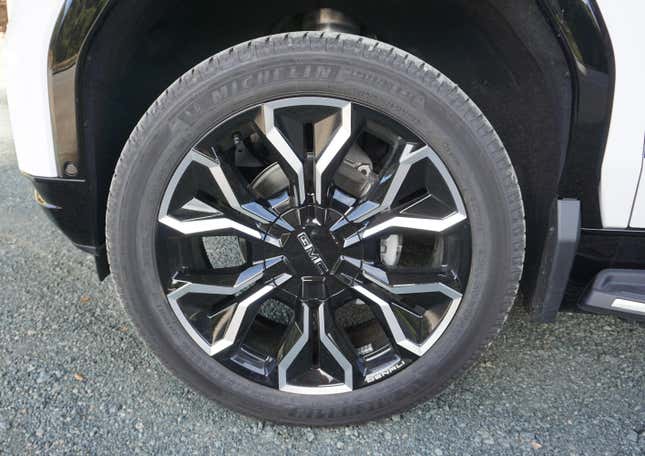
Still, there’s plenty to like about the Sierra EV Denali. Its powertrain, like most GM Ultium vehicles (or whatever they’re called now), is pretty solid. Like I already said, it’s got heaps of power and more range than you’ll ever really need. It supports 800-volt DC fast charging at up to 350 kW, which GM says will add about 100 miles of range in just 10 minutes. Be warned, though, the company isn’t quoting a 10-to-80-percent battery charge time because it probably takes a long goddamn while to fill up a 205-kWh battery. One upside of the battery, other than the 460 miles of range, is its ability to power your home in a power outage. You’ll need a whole bunch of GM’s proprietary equipment, but it’s a neat party trick nevertheless.

Something else the Sierra’s powertrain does well is regenerative braking. There are two intensity settings in addition to being able to turn it completely off, and both of them offer full one-pedal driving. One is just stronger than the other. I would often leave the car in its highest setting, but it is a bit jerky when you first let off the accelerator. Even in fully-off mode, there’s a paddle on the left side of the steering wheel you can use to engage regen as you like. It’s progressive too, so the more you squeeze it, the faster you slow down.
Being a high-end General Motors product, the Sierra EV Denali comes with GM’s best piece of technology: Super Cruise. Like in every other application, Super Cruise gives you the best Level 2 hands-free driving on the market. It works wonders both in traffic and while cruising down the highway. It’s even pretty aggressive about automatically changing into faster lanes for you, which is great if you’re someone like me who hates being behind others.
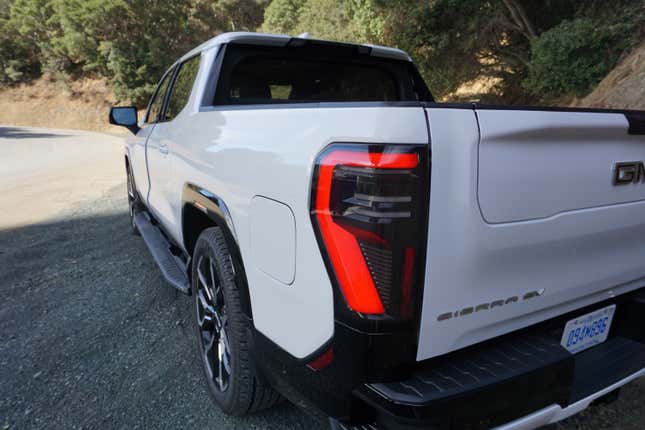
Another thing the Sierra EV Denali has going for it are its good looks. The exterior definitely looks like a GMC truck with its upright grille that the brand calls a shield, C-shaped running lights and overall massive presence. The 24-inch wheels, while compromising comfort, do admittedly look very good. When it comes to other EV trucks on the market, I’ve gotta say I think this is the best looking one money can buy. It’s definitely a better looker than the Chevy Silverado EV, and it’s miles prettier than the sales-leading Tesla Cybertruck. I also dig that, unlike most ICE-powered trucks, it’s one seamless body panel along the side instead of having a gap for the bed.
Inside, I’m happy to say the interior and tech is nearly good enough for the Sierra Denali EV’s price tag. Pretty much everything you touch is real metal, quality-feeling leatherette or real open-pore wood. The only hints of cost cutting can be found on the lower door panels, the top of the dashboard by the heads-up display housing and grab handles. What can you do?
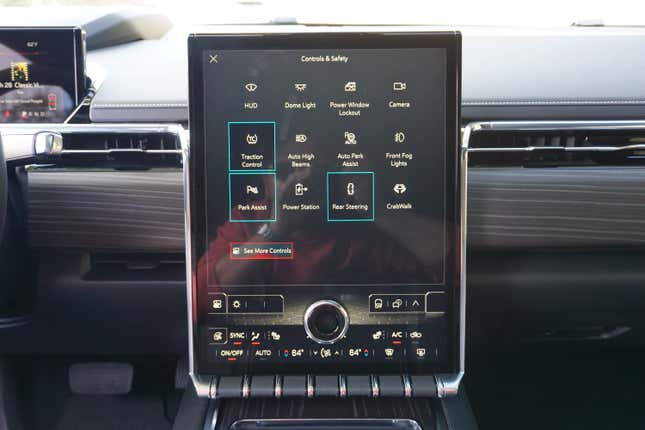
It’s all laid out rather well, too. In the middle you’ve got a massive 16.8-inch vertical screen, which is honestly one of the best systems in the business. It’s easy to use, there are hard buttons for volume and climate control, and it’s customizable enough that all of your most-used features will fall easily to hand. It’s flanked on the driver’s side by a 11-inch digital gauge cluster display that’s also plenty customizable and can show a full navigation map. In my driving position, the top edges are cut off by the steering wheel, but your results may vary. Above that is a 14-inch head-up display that is very clear and gives you all sorts of relevant information. I just wish its housing wasn’t so nasty looking.

Like all huge trucks, interior space and storage is a high-point. By my count, there are 11,000 cupholders inside the Sierra EV Denali, including a few in its 11-cubic-foot power-operated frunk. Rear passengers also have oodles of room even with the front seats as far back as they can go. Unfortunately, the heated and cooled front seats aren’t the most supportive things in the world, and they lack a massage function (which this truck should have), but they’re not going to kill your back on a long drive.
All of that goodness plays second fiddle to the truck’s party piece: The Multi-Flex Midgate. Sure, it’s a little bit of a gimmick, but who doesn’t love one of those? Like on the Silverado EV, you can remove the rear firewall and window to create up to 10 feet and 10 inches of room from the back of the front seats all the way to the end of GMC’s Multi-Pro Tailgate. With the tailgate up, it’s still got 9 feet of storage. For reference, with the Midgate in place, the Sierra EV’s bed is 5-foot-11.
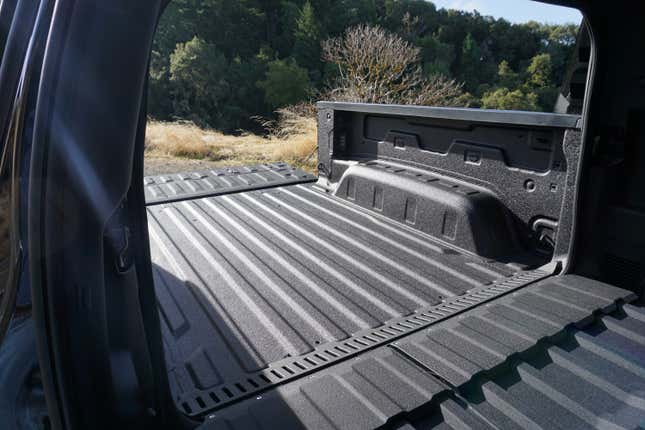
It’s also not too much of a pain in the ass to take down and put it back up. First, you flip the 60/40 split-folding rear seats down. Then you press a button to release the rear glass, which isn’t as unwieldy as you’d think, and clamp it into place on the rear firewall. From there, just push another button and it comes down. If you don’t need the entire Midgate down, you can leave the rear window in place, too. The whole process is easier than taking the doors and roof off of a Jeep Wrangler or Ford Bronco. GM really thought it through, and while it won’t always be useful, it’s a fun party trick.
When it comes to pricing, well, the Sierra EV Denali is not cheap. I know, that’s shocking to you. The Max Range truck starts $100,495 (including $2,095 for destination), and the only real options are paint colors that range from $495 to $3,995 for a very pretty color called Moonlight Matte, as well as a tonneau cover and a bed rack. There is a cheaper Denali Extended Range model with 390 miles of range coming later in 2025 that starts at $91,995. I know these prices seem high, but look around — nearly every big electric truck costs this much if not more.

There’s a lot to like about the 2025 GMC Sierra EV Denali. It looks good, it’s got lots of power, it has solid tech and its range is just about the best in the biz. I just cannot help but think it could have been way better if GMC cut down on some of the specs to make a lighter truck. The Sierra’s weight is sort of a self fulfilling prophecy — it’s so heavy because it has a big battery, and it needs such a big battery because it’s so heavy. The only way to change these facts is to completely re-engineer the truck, and that’s just not happening.
Because of that, we’re stuck with a truck that is nearly very good, but it’s held back by its own dynamic limitations. I know, you don’t buy a 9,000 pound truck for good driving dynamics, but when they verge on dangerous in everyday conditions, it’s something that needs to be talked about. I don’t really know how GM will remedy this situation or if it even will try. I’m fairly certain GMC will sell every single one they build, and I understand it. Overall the Sierra EV is a good truck, it just wants to kill you a little bit, so you better hold on tight.
